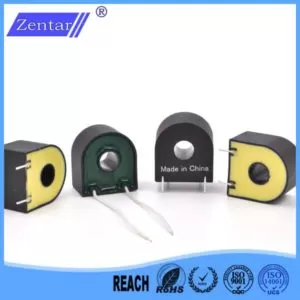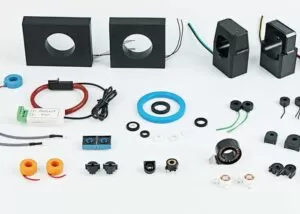Empowering the Future of Mobility with Safe Charging Solutions
The rapid rise in new energy vehicles over the past two years has necessitated an equally robust expansion in charging infrastructure. Ensuring the safety of electricity during charging, particularly in preventing leakage currents that can endanger lives and property, is crucial.
Residual Current Devices (RCDs) are vital in low-voltage power distribution systems, safeguarding against electric shocks, equipment leakage, and fires. These protectors are indispensable in electric vehicle charging, serving as fundamental safety devices.
Our zero phase current transformers, Type A and Type B, are designed specifically for EV charging modules, aligning with the critical modes outlined in GB/T 18487.1-2015:
- Mode 1: Direct AC grid connection via a charging cable. This method relies on building-level RCDs and is considered unsafe without them.
- Mode 2: Incorporates an on-cable control and protection device (IC-CPD) with built-in residual current detection.
- Mode 3: Utilizes specialized AC charging piles with integrated control devices.
- Mode 4: Connects to AC or DC grids through DC charging piles with control guidance functions.
For modes 3 and 4, it’s essential to select the appropriate residual current protector—either Type A or Type B—as specified by GB 14084.2-2008, GB 16916.1-2014, and GB 22794-2008 standards. Our products are expertly designed to meet these rigorous requirements, ensuring reliable protection in every charging scenario.
Understanding Type A and Type B Residual Current Protectors
As electric vehicles become ubiquitous, ensuring charging safety is paramount. While Type A RCDs are common due to cost considerations, upgrading to Type B RCDs offers enhanced protection against diverse leakage currents. Magtron’s innovative B-type leakage protection solution provides a cost-effective upgrade path, ensuring safety and reliability in charging infrastructure.
China’s RCD Guiding Standard, GB/Z 6829-2008 (aligned with IEC/TR 60755:2008, MOD), classifies RCDs based on product structure, residual current type, and trip methods.
Types of Residual Current Protectors:
- AC Type: Designed to trip on suddenly applied or slowly rising residual sinusoidal AC current.
- Type A: Includes AC type characteristics and superimposes 6mA of pulsating DC residual current to ensure effective tripping.
- Type B: Offers Type A features and additional protection, capable of detecting and tripping on a broader range of residual currents, including low-frequency AC residual currents and various DC residual currents.
Importance in EV Charging Safety
While Type B RCDs provide comprehensive protection, their higher cost leads to widespread use of Type A RCDs in domestic AC charging piles. However, it’s crucial to assess if Type A protectors adequately address all potential leakage currents during charging.
Leakage Currents in Charging:
During AC charging, damage to insulation in the charging pile or vehicle coupler may result in power frequency AC leakage currents. In the vehicle’s on-board charger, leakage mainly arises from the AC/DC and DC/DC circuits.
- AC/DC Circuit: Converts single-phase AC power to stable DC voltage for charging. Insulation damage here can cause pulsating DC residual currents.
- DC/DC Circuit: Further converts DC voltage for battery charging. Insulation faults may lead to residual DC currents with low ripple.
Evaluating Type A Protection:
While Type A RCDs can handle certain leakage scenarios, they may fall short in detecting all types of DC residual currents during charging. This could pose safety risks, especially in cases where insulation damage occurs in the DC/DC circuit.
The following picture illustrates the generation and harm of DC residual current in detail (for reference)
Understanding DC Leakage in Charging Systems
In the DC/DC part of the push-pull full-bridge converter, DC leakage may occur, especially in China’s TN power supply system. Here, the equipment’s metal shell is connected to the working neutral line, allowing DC leakage to flow through the body and PE line, impacting the entire system’s current waveform. While TN systems mitigate risks by limiting voltage on the body, faults like missing ground wires or disconnected PE lines pose serious hazards, particularly in rural areas where such issues are prevalent.
The Case for Type B RCDs
Existing A-type RCDs, designed to detect pulsating DC leakage, have limitations. When DC leakage exceeds 6mA, A-type RCDs can malfunction due to core pre-magnetization, rendering them ineffective. Hence, upgrading to B-type RCDs is imperative for comprehensive protection, especially in DC charging piles where off-board chargers convert commercial power into precise DC power for battery charging.
Ensuring Future Safety in Charging Infrastructure
As new energy vehicles become commonplace, charging piles will play a pivotal role in daily life. Ensuring their safety is paramount, necessitating the replacement of outdated residual current protectors with advanced solutions. Magtron’s innovative SoC chip solution, based on iFluxgate technology, digitally integrates B-type leakage protection. This cost-effective upgrade enhances the safety of charging equipment, offering peace of mind as electric mobility becomes the norm.







